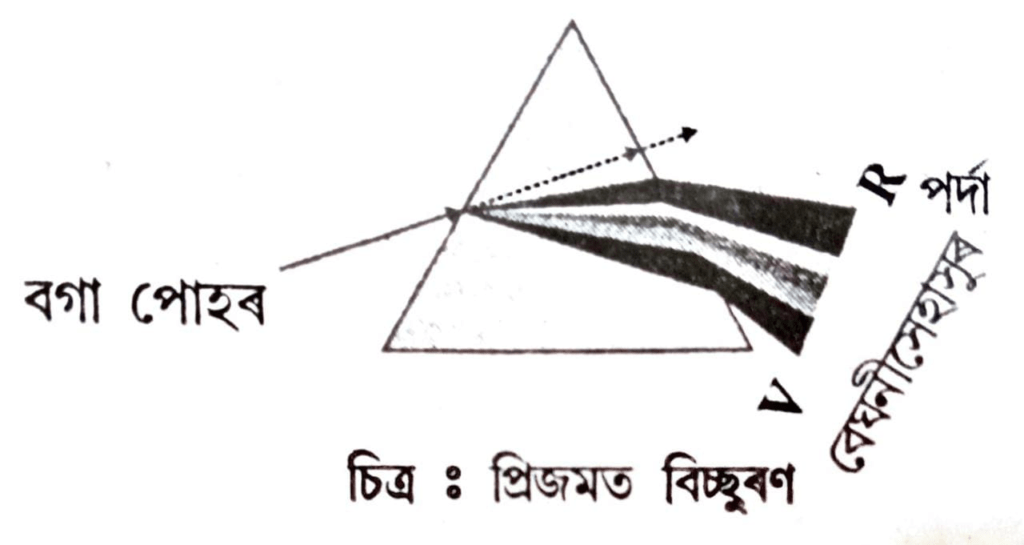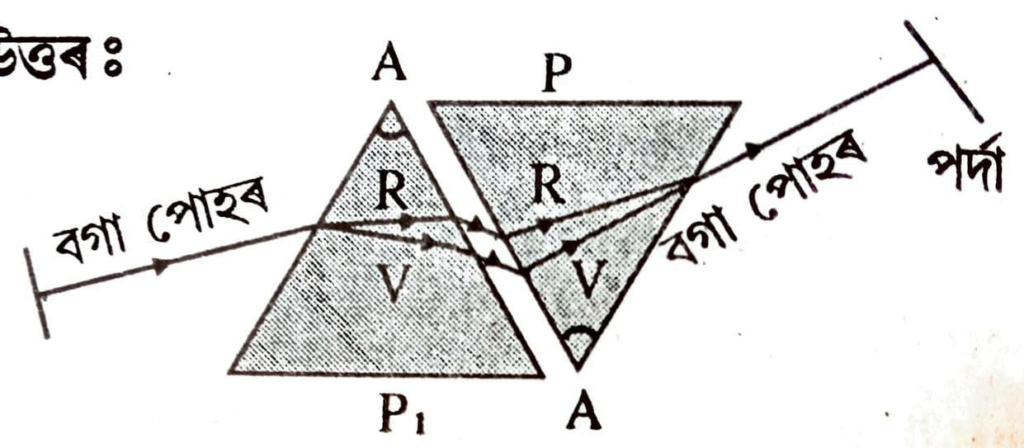Class 10 Science MCQ Chapter 11 The Human Eye and the Colourful World, Class 10 Science MCQ Question Answer, Class 10 Science Multiple Choice Question Answer to each chapter is provided in the list of SCERT Science Class 10 Objective Types Question Answer so that you can easily browse through different chapters and select needs one. Class 10 Science MCQ Chapter 11 The Human Eye and the Colourful World Question Answer can be of great value to excel in the examination.
SCERT Class 10 Science MCQ Chapter 11 The Human Eye and the Colourful World
SCERT Class 10 General Science MCQ Chapter 11 The Human Eye and the Colourful World Notes covers all the exercise questions in SCERT Science Textbooks. The NCERT Class 10 Science MCQ Chapter 11 The Human Eye and the Colourful World provided here ensures a smooth and easy understanding of all the concepts. Understand the concepts behind every chapter and score well in the board exams.
The Human Eye and the Colourful World
Chapter – 11
Multiple Choice Questions & Answers
1. Which of the following parts provides the finer adjustment of focal length required to focus objects at different distance on the retina
(a) Cornea.
(b) Iris.
(c) Crystalline lens.
(d) Pupil.
Ans: (c) Crystalline lens.
2.Which of the following parts of eye controls the amount of light entering the eye-
(a) Pupil.
(b) Cornea.
(c) Lens.
(d) Ciliary muscles.
Ans: (a) Pupil.
3. Which of the following parts of eye changes the curvature of the eye lens?
(a) Cornea.
(b) Iris.
(c) Pupil.
(d) Ciliary muscles.
Ans: (d) Ciliary muscles.
4. For a healthy eye, the near point of the eye is situated from the eye at-
(a) Infinity.
(b) 25 cm
(c) 2.5 cm
(d) 25 m
Ans: (b) 25 cm
5. For a healthy eye, the far point of eye is situated at-
(a) 25 cm
(b) 100 cm
(c) Infinity.
(d) 100 km
Ans: (c) Infinity.
6. If the far point of a person moves towards the person and is situated closer to the eye, then the defect of vision he is suffering from-
(a) Myopia.
(b) Hypermetropia.
(c) Presbyopia.
(d) None of these.
Ans: (a) Myopia.
7. If the near point of a person is situated away from the normal distance of 25cm from the eye, the defect of vision he is suffering from-
(a) Presbyopia.
(b) Myopia.
(c) Hypermetropia.
(d) None of these.
Ans: (c) Hypermetropia.
8. The defect of vision that arises due to the decrease in the power of accommodation of eye with ageing-
(a) Myopia.
(b) Presbyopia.
(c) Hypermetropia.
(d) None of these.
Ans: (b) Presbyopia.
9. The angle made by the emergent ray of a prism with the direction of the incident ray is called –
(a) Angle of prism.
(b) Angle of emergence.
(c) Angle of refraction.
(d) Angle of deviation.
Ans: (d) Angle of deviation.
10. Light of which colour is bent the least when a beam of white light passes through a prism?
(a) Blue.
(b) Violet.
(c) Red.
(d) Orange.
Ans: (c) Red.
11. Light of which colour is bent the most when a beam of white light passes through a prism?
(a) Violet.
(b) Red.
(c) Yellow.
(d) Blue.
Ans: (a) Violet.
12. The first scientist who used prism to get a spectrum of sunlight was-
(a) Galileo.
(b) Tyndall.
(c) Newton.
(d) Fleming.
Ans: (c) Newton.
13. The phenomenon of light responsible for the formation of rainbow after a rain shower-
(a) Reflection.
(b) Refraction.
(c) Scattering.
(d) Dispersion.
Ans: (d) Dispersion.
14. For which of the following phenomena we see the advance sunrise and delayed sunset?
(a) Refraction.
(b) Reflection.
(c) Dispersion.
(d) Scattering.
Ans: (a) Refraction.
15. Which of the following phenomena of light is involved in the twinkling of stars-
(a) Reflection.
(b) Scattering.
(c) Dispersion.
(d) Refraction.
Ans: (d) Refraction.
Very Short & Short Type Questions and Answers:
1. Where is image formed inside the eye?
Ans: At the retina.
2. Name the part of the eye through which light enters the eye.
Ans: Cornea.
3. What is the diameter of the eyeball?
Ans: About 2.3 cm.
4. What is the function of the crystalline lens of the eye?
Ans: The crystalline lens of eye provides finer adjustment of the focal length required to focus objects ar different distances on the retina.
5. What is the nature of the crystalline lens of the eye?
Ans: Convex.
6. Which controls the size of the pupil of eye ?
Ans: Iris.
7. What is the function of pupil?
Ans: To regulate and control the amount of light entering the eye.
8. What is the nature of image formed by the eye lens on the retina?
Ans: Real, inverted.
9. What is retina?
Ans: It is a delicate membrane found at the back of the eyeball which has numerous light-sensitive cells.
10. Which controls the curvature of eye lens?
Ans: Ciliary muscles.
11. What is least distance of distinct vision?
Ans: The minimum distance at which objects can be seen most distinctly without strain is called least distance of distinct vision.
12. What is near point of eye?
Ans: The minimum distance at which objects can be seen most distinctly without strain is called least distance of distinct vision.
13. What is the value of least distance of distinct vision or the near point for an adult with healthy eyes?
Ans: About 25 cm from the eye.
14. What is the far point of eye?
Ans: The farthest point upto which the eye can see objects clearly is called the far point of eye.
15. Where is the far point situated for a healthy eye?
Ans: At infinity.
16. What is the range of vision for healthy eye?
Ans: From 25cm form the eye to infinity.
17. What is cataract?
Ans: Sometimes the crystalline lens of people at old age becomes milky and cloudy. This condition is called cataract.
18. What are the defects of vision?
Ans: Myopia (Near sightedness], Hypermetropia (Far sightedness) and presbyopia.
19. What is myopia or near sightedness?
Ans: The defect of vision in which a person can see the nearby object, distinctly but cannot see the distinct objects, clearly is called myopia.
20. How can the defect of myopia be corrected?
Ans: By using concave lens of suitable power.
21. What is hypermetropia or far sightedness?
Ans: The defect of vision in which a person can see the distant objects clearly but cannot see the nearby objects distinctly is called hypermetropia.
22. How can hypermetropia be corrected?
Ans: By using convex less of suitable power.
23. What is presbyopia?
Ans: The power of accommodation of the eye usually decreases with ageing. For most people the near point gradually recedes away. So the person finds it difficult to see nearby objects distinctly. This defect is called presbyopia.
24. What is the angle of prism?
Ans: It is the angle between two lateral rectangular surfaces of a prism.
25. What angle of deviation of a prism?
Ans: It is the angle made by the emergent ray with the direction of incident ray.
26. Draw the angle of deviation formed during the refraction of light through a triangular glass prism.
Ans:

27. What is dispersion of light?
Ans: When white light passes through a prism it splits into seven constituent colours. This phenomenon is called dispersion.
28. Draw ray diagram for dispersion of white light by a prism.
Ans:

29. Draw a diagram to show that a beam of white light passes through two prism without getting dispersed.
Ans:

30. Why do we are rainbow after a rain shower?
Ans: Due to dispersion of sunlight by the tiny droplets of water suspended in the atmosphere after a rain shower.
31. What is scattering of light.
Ans: When light rays get incident on some tiny particles like the molecules of air or the dust particles, they spread the light in all possible direction. This phenomenon is called scattering of light.
32. What is Tyndall effect?
Ans: When light rays get incident an some colloidal particles, they scatter the light to make the path of light visible. This is called Tyndall effect.
33. Light of which wavelength will be scattered most when white light passes through a medium containing very fine particles.
Ans: Light of shorter wavelengths in the blue end.
34. How does the colour of scattered light depend on the size of the scattering particles?
Ans: Very fine particles scatter mainly blue light which particles of larger size scatter light of longer wavelengths. When size of scattering particles is very large, then the scattered light may even appear white.
35. Why are the danger signal lights red in colour?
Ans: Because light of red colour is scattered least by the particles of the atmosphere. So it can be seen in the same colour at a distance.
36. Why do we need two eyes for vision instead of one?
Ans: Because two eyes provide a wider field of view for us (about 180°). Two eyes make us enable to see the faint objects. Two eyes also enable us to see the world in three dimensional form.
37. Who was the first scientist to use a prism to get spectrum of white light?
Ans: Sir Isaac Newton.
38. Why is twinkling of stars seen?
Ans: Due to atmospheric refraction of starlight.
39. What is white light?
Ans: Any light that gives a spectrum similar to that of sunlight is referred to as white light.
40. Arrange the following processes involved in the formation of rainbow in correct order.
Ans: Refraction and dispersion, Total internal reflection, Refraction.
41. What is power accommodation of eye?
Ans: The ability of the eye lens to adjust its focal length is called power of accommodation.

Hi! my Name is Parimal Roy. I have completed my Bachelor’s degree in Philosophy (B.A.) from Silapathar General College. Currently, I am working as an HR Manager at Dev Library. It is a website that provides study materials for students from Class 3 to 12, including SCERT and NCERT notes. It also offers resources for BA, B.Com, B.Sc, and Computer Science, along with postgraduate notes. Besides study materials, the website has novels, eBooks, health and finance articles, biographies, quotes, and more.




